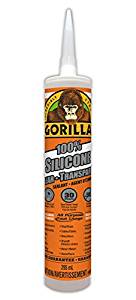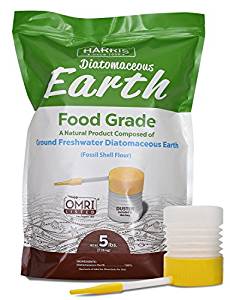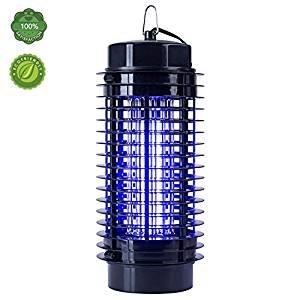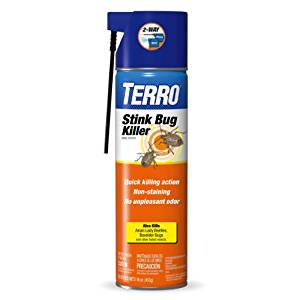How to Get Rid of Stink Bugs: DIY & Exterminator Quotes
If you are looking for how to get rid of stink bugs, read our detailed guide. We included DIY methods and 4 free exterminator quotes.
It’s fall and everything around you begins to change. The air becomes cooler, the leaves are changing, nights seem unending and days are shorter. But before you start to enjoy the beautiful scenery of leaves changing their color, you notice one of the unfavorable signs that winter is around the corner; the influx of stink bugs. Famous for their not-so-pleasant smell, stink bugs are likely to start frequenting your home as the cold season approaches.
As a homeowner, you might spot a brown bug flying through the window or crawling on your walls. If you don’t recognize this smelly bug, you will probably swat it and then out of nowhere; you will be subjected to nauseating pungent fumes only to learn that you killed a stink bug.
Stink bugs are common insects in most homes, and you are likely to spot one or two crawling on your curtains or walls. Stink bugs are tiny insects with a shell-like exterior, with mottled grey to brown bodies. They are common in most parts of U.S, California, Oregon, Washington, Texas and many other parts of the world.
Other than their notorious smelly fumes, these little smelly bugs are actually not dangerous to humans. They will bite or sting you. They also do not transmit diseases, pathogens or bacteria. Their smelly toxic fumes are not toxic. The nasty smell they emit when they are threatened, disturbed or killed is supposed to ward off predators, and in this case humans.
When spring approaches, stink bugs come out of their hiding spots in huge masses. If you have never seen them, it will be shocking to see a large number of these tiny bugs flying around as they try to find their way out. In fact, they like flying around in masses meaning you might actually come across a huge population of these stinky insects congregating in your home.
During winter, stink bugs will find their way inside your home as they look for warm conditions. They will most likely seek shelter in your basement, cracks, and crevices or any other place that provides ideal conditions for them. Stinky bugs are some of the most difficult bugs to control once they enter your home. This is because, once they start coming out, they will find their way into your home in large numbers.
Stink bugs can enter your home through windows and doors trims, cracks beneath baseboards, through light fixtures around exhaust fans and any other open space into your home. Normally, our homes do not offer the environment for stink bugs to reproduce; but, they will find their way inside your home in large numbers as they seek for warmth.
Even though they may not harm you directly, stink bugs can cause harm to agricultural crops. The chew and poke fruits and vegetables. Farmers report losses due to stink bug activities that leave crops such as apples, tomatoes, and vegetables with aesthetic damage. They will poke and suck out the juice in fruits and tomatoes. They also plunge their beaks into corn husk and feed on the nutritious parts of the corn. Since they fly in large numbers, they can cause significant damages in your garden if you have a small one.
How Do Stink Ants Look Like?
Stink bugs have a triangular shape and are about ¾ inch long. Their body color is somewhere between mottled grey and brown. Nymphs vary in colors from black and white while some have white spots but disappear as they mature. They have six legs and antennae protruding from the top of their head. Stink bugs have wings which they use to fly around when they are looking for a warm environment as winter approaches.
What Do Stink Bugs Feed On?
Stink bugs are plant feeders. Their diet mostly consists of leaves, stems, fruits, flowers, and crops such as soybeans. They usually use their tiny mouth to poke the skin of a fruit. The insect will then inject some amount of saliva into the fruit. Since their saliva is toxic to the fruit cells, it will damage the fruit leaving it with scars as the fruit develops. The scars make the fruit have dark spots and interferes with its aesthetic appearance.
Several species of stink bugs feed on ornamental plants, on seeds of fruits and vegetables. Most common type of plants that attract these little insects include weeds, grasses, peach trees, peanuts, pecan trees, corn and other types of grains. If they invade your garden, stink bugs will be attracted to berries, sunflowers, peppers, tomatoes, and apples. They will also find their way to your eggplants, beans, and okra if its present in your garden.
Stink bugs are also fond of feeding on stems of plants and leaves. On top of destroying the appearance of fruits, stink bugs make the fruits attractive to other insects. Due to their toxic saliva, stink bugs spread diseases to the fruits, thus, destroying them and making them unfit for consumption or sale.
Stink bugs will mostly feed on crops that are on season. They start feeding on weed and grasses and then move to ornamental plants and fruit trees. After feeding on crops on the season, stink bugs will then move to your garden and feed on whatever fruits or trees available. When stink bugs nibble or poke your plants, they leave them with holes that have a dark area below them. If they feed on fruits, they will leave them looking dark with bitter spots inside.
However, even though most types of stink bugs are plant feeders, there are some species of stink bugs that do not feed on plants, rather, they are predatory. The predatory stink bugs feed on insects that feed on plants, and most farmers find this species of stink bug beneficial to them. The predatory stink bug will feed on root weevils, velvet bean caterpillar, potato beetles and many other plants destroying insects. They will eat the eggs, the larvae, nymphs and also the adult of most of the plant-eating insects. In fact, the predatory stink bugs are known to feed on over 100 species of insects. Both the nymphs and adult stink bugs are known to feed on a majority of insects.
When they invade your home, you would be surprised to learn that they typically feed on nothing inside your home. Mostly, the reason why stink bugs find their way inside your home is to look for a warm place to overwinter. During this time, stink bugs do not feed until the warm season comes back.
What Are Their Habitats?
Stink bugs can mostly be found in gardens, farms, and orchards. They will occasionally find their habitat inside homes and other structures to shelter during the cold season to overwinter. Once they get inside your home, stink bugs will look for dark places that are warm, with fewer human interference.
The most common species of stink bug that you are likely to find inside your home is the brown marmorated stink bug. As the weather starts getting cold, these species of stink bugs will find their way to your home in large groups. During the warm weather, stink bugs congregate in large groups on the sides of a building.
Are Stink Bugs a Threat?
Stink bugs do not bite either sting. Just like mosquitoes, bedbugs and biting flies, stink bugs have piercing mouthparts, but instead of sucking blood, they use the mouth to suck out juice in fruits and plants. In fact, the design of their mouths cannot enable them to bite, sting, or pierce through the human skin.
However, stink bugs can invade your home in large numbers and become a nuisance and make your living space unsettling and uncomfortable. Because of their tendency to spread in big numbers, once they attack your garden, stink bugs can cause significant damages. They destroy fruits and leaves and make them susceptible to destruction by other fruit-eating insects.
Signs That You Have Stink Bugs Infestation
Stink bugs invade homes in big masses, thus; it would be very hard to miss them when they enter your home. If they are present in your home, you will find them lying around your home especially on the sunny sides of your house. Inside your house, stink bugs will be hanging on your curtains, walls and dark places.
If you spot several stink bug inside around your home, it’s possible that you already have an infestation. Stink bugs are known to come in huge population when looking for a place to overwinter. If you see some in your house, search for the bigger population in dark paces in your house and other structures.
Another sign that could indicate that you a have stink bugs in your home is dead stink bugs. Since stink bugs move in masses, a lot of them die when they are trying to enter your house. If you have an infestation, you may start seeing lots of dead stink bugs lying around in your home. You will start seeing the dead stink bugs in entry points that are used by stink bugs to gain access to your house. Places where you may find dead stink bugs include around the doors, on window frames, in the chimney and utility pipes.
You may also start experiencing foul odors around your home. Stink bugs, as their name suggests, release a stinking smell when stamped on, or feel threatened. The foul smell released by stink bugs is their defense mechanism against predators such as lizards, birds, and humans.
How to Get Rid of Stink Bugs
Once spring comes by indicating the end of the warm days, it’s time to deal with all sorts of bugs and the most annoying of them all being the stink bugs. During spring, you will notice an influx of these foul-smelling bugs crowding every space in your home. Even though they don’t bite or sting, stink bugs can crowd your home and make your living environment unsetting, not to mention the foul smell they emit when you accidentally step on them.
Having stink bugs in your home can cause you a serious headache. Their awful smell can linger in your home for hours making your stay indoors quite unsettling and uncomfortable. There is a study that shows that stink bugs can cause dermatitis if your skin comes into contact with the foul-stinking liquid. These smelly tiny insects are a nuisance, and if you have a garden in your backyard, stink bugs can cause havoc to your fruits and plants.
Thus, its important find ways of eliminating stink bugs from your home. A stink bug infestation cannot go unnoticed. If they are present in your home, you will start seeing them everywhere around your home. However, getting rid of stink bugs is not an overnight task. You need to take your take time and employ several ways to eradicate these smelly bugs successfully.
Let’s look at prevention and eradication methods that can aid you in getting rid of stink bugs.
Seal Entry Points
When you are experiencing a bug infestation, the first step is to find entry points. Finding entry points mean finding out where the bugs are coming from, and their entryways to your home. You will then need to seal the entry points to prevent further infestation.
Stink bugs find their way into your home through cracks in the foundation and siding. They also enter through vents, chimneys, doors, window frames and any open place or holes in your home. Check your home to see if there are any cracks, crevices, holes, gaps, especially in your foundation, walls, and windows.
Once you find the entry points, you need to seal them. Sealing the entry points acts as an exclusion method meant to fend off these annoying bugs. The idea is to prevent their way in. If they cannot find an entry, you will not worry about more bugs finding their way inside your home. You can seal the entry points in vents, chimneys and any other possible entry points using mesh screening. If the screens have holes, you should patch them up to seal them.
Cracks and holes in your walls are the most common entry points used by all sorts of insects including stink bugs. The cracks and holes should be sealed using high-grade silicone caulk. You can purchase Gorilla silicone sealant caulk. The sealant will keep of stink bugs from gaining access to your home.

You can wipe the doorways, windowsills, and areas around the entry points with a scented dryer sheet. Stink bugs are repulsed by the smell of scented dryer sheets, and once they smell it, they will stay away from the area. Scented dryer sheets work better and have strong smell than the unscented ones.
The idea is to deter stink bugs from coming anywhere near the entry points, so the dryer sheets must be strongly scented if they are to work. In addition, you should wipe the surfaces with scented dryer sheets on a daily basis. The smell of scented dryer sheets can reduce almost 80% population of stink bugs in your home in a week or two.
Home and Natural Remedies
Once you have managed to seal all the possible entry points, you can try some home or natural remedies that effectively eliminate stink bugs. Let’s look at some of these effective home and natural methods that can reduce or get rid of the smelly bugs from your home.
Diatomaceous Earth (DE)
Diatomaceous earth is a food grade powder made from a natural sedimentary rock which contains iron oxide, silica, and alumina. DE is extremely fatal to insects but safe on animals and humans. Diatomaceous earth is commonly used as a pesticide to get rid of a big variety of insects that particularly invade most homes.
This natural powder works by breaking down the exoskeleton of insects and consequently causing them to dehydrate, and eventually, the insects die. It’s been proved to be extremely effective in eliminating intruding insects. To use DE, you should sprinkle the powder inside and outside your home. As you sprinkle DE, focus on entryways such windowsills, on doors and door frames alongside other areas where stink bugs seem to hang out frequently. Additionally, if you spot a live sting bug, you should directly dust the powder on it.
When purchasing diatomaceous, try to look for the unheated one. Heating the powder reduces its effectiveness. You can purchase food grade diatomaceous earth.

Use garlic
Garlic is another home remedy that works effectively in getting rid of stink bugs. These foul-smelling insects detest the smell of garlic, and they steer off from an area that has the potent smell of garlic. Garlic does not kill stink bugs; rather it repels them.
To prepare garlic repellent, you need to mix four teaspoons of garlic powder with two cups of water in a spray bottle. Use the solution to spray on the entry points, on windows, doors, on plant leaves, and any other area where stink bugs seem to gather frequently. If you have dark areas in your home, you should spray them with the garlic solution. You can also spread several pieces of garlic cloves in areas where stink bugs use as their hideout.
Use Mint Oil
Mint is another stink bug repellent. It has a strong odor that stink bugs hate and they will stay away from areas sprayed with mint oil solution. Mint oil won’t outrightly kill stink bugs in your home, but it will repel and keep them away.
To make a mint solution, you should mix ten drops of mint oil with two cups of water in a spray bottle. Spray the mint solution in windowsills, doors, and on possible entry points and other hideouts used by stink bugs in your home. You can opt to use ground mint leaves instead of using mint oil. If used regularly, you will start seeing a reduction in stink bugs and even other types of insects in your home.
Sprinkle Catnip
Catnip is also another effective stink bug repellent. It repels and scares away stink bugs instead of poisoning them. To use catnip as a repellent, you can sprinkle catnip powder around your home and in your garden. Make sure that you focus on areas where stink bugs tend to hide out or congregate.
If you want to keep repelling stink bugs always, you can grow the catnip plant in your garden. Catnip is classified as an herbal plant. This way, you will have a long-term repellent nearby that will repel these stinky insects away from your home for good.
Use Neem Oil
Neem oil disrupts eating instinct of a stink bug. It also affects their mating instincts as well. When you spray neem oil in your home, stink bugs will end up starving themselves to death. In addition, due to the effect of the neem oil, stink bugs will not lay eggs, hence no reproduction. However, it takes about a week of application to notice a reduction in stink bugs.
To prepare neem oil spray, you should mix one liter of warm water with two spoons of neem oil in a spray bottle. Spray the neem oil solution on plant leaves, doors, windowsills, on possible entry points and on their hide-outs. Make sure you spray the neem oil solution every day for better results.
Hot Peppers
Hot pepper has a chemical composition known as capsaicin that gives it its heat. When hot pepper solution comes into contact with stink bugs, the heat in them burns the exterior part of their body and dehydrates them.
To make the pepper spray solution, you need to soak several hot peppers in water and let stay for a few hours. After the hot peppers have soaked, pour the pepper spray into a spray bottle. Spray this solution directly on live stink bugs especially in areas where they congregate in big numbers. Spray this mixture every day. After a week or two, you should start seeing a change in numbers of stink bugs in your home.
You need to extremely careful with the way you handle hot peppers. If you rub your eyes with hot pepper or accidentally spray it in your face, it can cause serious irritation and burn your eyes and skin. Make sure that you wash your hands thoroughly after mixing the hot pepper spray before doing anything else.
Use Soapy Water
Soap is an effective home remedy that kills the stinky insects by breaking down their exterior leaving them dehydrated. A mild dish wash is ideal for this method; it’s natural and safe. You can choose to use antibacterial soap, but it has a lot of chemicals as compared to non-antibacterial soap.
To make the soap water mixture, you will need to mix about 4 cups of dish soap and one liter of hot water. Spray the soap water solution directly to live stink bugs particularly in areas where stink bugs seem to hide out in large numbers. The good thing with the soapy water remedy is that it requires simple ingredients which are readily available in your kitchen.
Physical Removal
You can use physical methods alongside the home natural method and repellents to get rid of stink bugs. When stink bugs get inside your home, they do not build nests, neither do they breed and reproduce. They also won’t feed on anything inside your home. The only thing they will be looking for is a warm place to overwinter. Thus, if you use physical removal methods, you will be able to get rid of these stinky tiny insects for good.
Here are some of the effective physical methods that can be used to get rid of stink bugs.
Vacuum the Stink Bugs
Vacuuming may seem like a pretty simple solution of getting rid of stink bugs, but it’s quite effective. In fact, it’s one of the quickest and safest methods of eliminating stink bugs. Use an industrial vacuum cleaner that has a bag to suck up these foul-smelling insects. After vacuuming, remove the bag and dispose of immediately.
The problem with stink bugs is that that they stink once they are threatened or killed. So, after you vacuum them, your vacuum cleaner will be left with the bad smell for weeks or even months. Thus, it’s prudent to make sure that you vacuum these stinking little bugs using a vacuum cleaner with a bag. After vacuuming, empty the dead stink bugs in a garbage bag and make sure that you seal it tightly. This way, you won’t be left with a stinking vacuum and your home will not be affected by the foul smell either.
Use A Soapy Trap
Fill a bucket with four liters of water and mix a teaspoon of liquid soap or dish detergent. Mix the soapy solution until it bubbles. Place the bucket at the spot where stink bugs seem to gather frequently. Turn on a lamp and set it close to the bucket with soapy water. The idea is to illuminate the bucket of water and draw stink bugs to it.
Stink bugs, like any other insect, are attracted to light. They will fly towards the light and also get drawn to the soapy solution. They will them get into the soap mixture, and since they can’t move in the soapy solution, they will eventually drown. The soap trap is probably one of the methods that are stink free and easiest to use. The soap method can also be used to eliminate other types of insects such as fleas and houseflies.
Electrocute the Insects
Another effective way of physically eliminating stink bugs is by using insect electrocution system also known as bug zappers. The bug zappers have a bright light that draws insects including stink bugs to it. Once a stink bug approaches the electrocution system, it suddenly gets shocked, and the impact is so strong, that it kills it instantly.
Bug zappers are available in stores. You can purchase Aspectek Powerful Electronic Insect Killer or TBNEVG Powerful Electric Bug Zapper.


You should set the insect electrocution system in dark spaces in your home that are likely to attract stink bugs or in the attic. Follow the manufacturer’s instructions on how to position and set the electrocution system. For better result, turn it on at night when the bugs are busy. In the morning, you can vacuum the electrocuted bags and dispose of.
Use A Fly Tape
Fly tapes work effectively in eliminating a variety of insects. However, if you choose to use a fly tape to capture bugs, you should be ready to deal with the awful smell emitted by these pesky smelly insects. This is because the fly tape does not kill insects instantly, rather, it traps them, and eventually, the insects die.
Place fly tape in areas that you have established to be the entryways used by stink bugs such on the doorways, on windowsill, vents, cracks and other places where the insects gather frequently. Keep checking the tape every day to see if it has filled up. If it fills up with insects, discard it and replace it with another one until all the stink bugs in your home are cleared up. Fly tapes are available in stores near you at little cost of about $6.50 for a three pack.
Use Stink Bug Spray
If you are looking for a quick solution to eliminate stink bugs, you can opt to spray the annoying insects with insecticide. However, the use of insecticides is not usually recommended by experts, and it should be your last option. When you choose stink bug spray, you should be prepared to deal with the stinking mess left behind after the bugs die. Removing dead stink bugs after spraying stink bug spray can be a tedious task, not to mention a smelly one at that.
You can purchase Terro Stink Bug Killer Spray. Spray it directly onto the bugs especially in areas where they gather in large numbers. While stink bug spray will kill the stink bugs present in your home, it won’t stop others from finding their way into your home. Therefore, you should also make sure you that you make use of repellents and seal entry points.

In addition, you should make sure that you dispose of the dead stink bugs as soon as possible. Leaving dead stink bugs can easily attract carpet beetles, which can end up damaging your home.
Ways to Keep Stink Bugs Away
Once you succeed in getting rid of stink bugs, you need to make sure that you keep them out and prevent the infestation from happening again. Let’s look at the effective ways that will enable you to keep these smelly little bugs away from your home.
✓ Seal Windows, Doorways and Entry Points in Your Home
As mentioned earlier in this guide, sealing entry points is one of the most effective ways of keeping stink bugs and other types of insects and pests away from your home. Start by sealing cracks and holes in your door trims and windows using caulk. These two (windows and doors) are the most common entry points for stink bugs. Other common entry points include ceiling lights, baseboards, cracks on walls and foundation. Sealing the entry points will reduce the chances of stink bugs getting inside your house.
In addition, you should cover air vents, chimneys, dryer vents and any other open areas that serve as a connection between the outside of your house and the inside. Inspect your home and identify these open areas and place protective screens to cover them. If you come across holes that are one-inch-wide or more, you should patch them up using epoxy or instant adhesive.
✓ Control Weeds Outdoor
Stink bugs are attracted to weeds. If your home has a considerable number of weeds, stink bugs will find it appealing. Unless you get rid of the weeds or reduce its amount, it will be difficult to keep the smelly insects away from your home. Take measures and control weeds in your yard and flowerbeds to make your outdoors less appealing to stink bugs. If you have fewer or no stink bugs in your outdoors, the chances are that you will not have to worry about their presence indoors.
When to A Call Professional
If you have tried the various home remedies and pesticides with no notable changes with the stink bug infestation in your home, you can seek professional help. Sometimes the sheer size of sting bug infestation can be overwhelming. If the situation is that bad, you should not delay on calling a professional stink bug exterminator. The earlier you take care of the infestation, the better.
A professional pest control expert will easily identify the entry points and inspect your home to know the hide-outs. The professional will then seal off the entry points and use professional grade insecticides and repellents that will get rid of stink bugs and completely keep them away.
| Professional Costs | Cost |
|---|---|
| National average professional cost | $175 |
| Typical cost range for stink bug extermination costs | $110-$265 |
| Low-end cost | $55 |
| High-end cost | $500 |
The average cost of hiring insect control professional ranges from $110 to $265. A one-time treatment will cost you about $300 to $550. The initial visit will involve a thorough inspection to identify the entry points, assessing the size of the infestation, and determining a treatment plan. The initial visit should cost you about $180 to $190.
After the initial treatment, a professional might need to schedule for periodic visits to monitor the stink bug situation and prevent the possibility of a re-infestation. The periodic visits can be monthly, semi-monthly or in some cases; they can be quarterly.
Here are the average costs for periodic visits:
| Stink bug control-Professional Periodic visits | Average costs |
|---|---|
| Monthly visit | $40-$50 |
| Semi-monthly visit | $50-$65 |
| Quarterly visit | $100-$350 |
Conclusion
All through the year, stink bugs feed and breed outdoors, but as soon as temperatures start dropping in the fall, they start flying around looking for a warm place to overwinter. They will seek shelter in holes, cracks and dark places. Since they spend their winter hibernating, meaning they are dormant you might actually not know that you have stink bug infestation. As the season starts to change, you will suddenly experience an influx of these stinking bugs as they come out to look for food. You will see them hanging on your windows, doors and other dark places.
Stink bugs generally do not harm humans directly; they don’t bite or cause damages to your home. But, true to their name, they stink. When threatened or disturbed, stink bugs release an awful smell which is a defense mechanism against predators. Even though they pose no real danger to humans, stink bugs, and their stinking fumes are a nuisance when they invade your home. They can also nibble and poke fruits, leaves and plant stems and cause damages when they invade your garden.
To get rid of them, you need to seal possible entry points, control weeds in your garden and use both home remedies and physical elimination methods. If the infestation is too big for you to handle on your own, you should consider hiring a professional pest control expert to get rid of the infestation.
